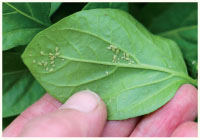|
 When scouting for aphids, examine the leaves, along stems and the new growth of peppers, tomatoes, eggplants, cole crops and leafy greens. When scouting for aphids, examine the leaves, along stems and the new growth of peppers, tomatoes, eggplants, cole crops and leafy greens.
The increased cost of food and concerns for food-borne diseases has fueled gardeners demand for vegetable bedding plants. Growers need to produce high quality pest-free vegetable transplants to meet this increased demand. A review of pesticide labels indicates that there are fewer insecticides and miticides labeled for greenhouse-grown vegetable bedding plants compared to ornamental bedding plants.
Start clean, stay clean
Pest management on vegetable bedding plants begins with a clean, weed-free, disinfected greenhouse. Grow transplants off the ground in a well-ventilated house. Avoid overfertilizing transplants, especially with nitrogen-based fertilizers to prevent lush growth that is more susceptible to aphids, whiteflies and spider mites.
If feasible, use separate houses for vegetable seedlings and ornamental bedding plants. Advantages to operating separate houses include:
- Vegetable seedlings are protected from any pests that may migrate from ornamentals and plants that are held over.
- Vegetable seedlings are protected from tospoviruses and cucurbit seedlings are protected from powdery mildew-infected verbena.
- It is easier to treat the vegetable seedlings if pesticides are needed.
Early problem detection
Regular, weekly scouting helps to detect problems early. This early detection and treatment result in better pest control since plant canopies are smaller and better spray coverage can be achieved.
Use yellow sticky cards to trap and detect adult stages of fungus gnats, thrips and whiteflies. Inspect and replace the cards weekly to keep track of population trends.
Focus on scouting indicator plants which are those plants or cultivars that have serious, persistent pest problems every year. Examine the undersides of leaves for insect and mite pests and inspect root systems to determine whether they are healthy.
Some common arthropod pests on vegetable bedding plants include aphids, broad mites, fungus gnats, shore flies, spider mites, thrips and whiteflies.
Biological controls
Vegetable bedding plants with only one or two key insect pests or with a longer production schedule are potential candidates for biological controls. Purchase natural enemies from a reliable biological control supplier. This will ensure a consistent supply of viable, high quality natural enemies that are shipped in a timely manner. Obtain specific directions from biological control suppliers on proper release rates and timing.
For information on compatibility of pesticides and natural enemies, consult the online databases of Koppert (www.koppert.com) or Biobest (www.biobest.be). Check under “Side Effects.”
Aphids
Green peach, melon and foxglove aphids may occur on vegetable transplants. Large numbers of aphids will stunt and deform plants. Foxglove aphids cause significant leaf distortion.
Examine the foliage, along stems and new growth of peppers, tomatoes, eggplants, cole crops and leafy greens. Signs of aphid activity include shed white skins, shiny honeydew, curled new leaves, distorted growth and the presence of ants.
Yellow sticky cards help detect the entrance of winged aphids into greenhouses from outdoors. Yellow cards will not, however, allow you to monitor aphids within the crop, as most aphids are wingless.
Controls: Insecticides labeled for aphids include azadirachtin (Aza-direct*, AzaGuard*, Azahar*, Azatin XL, Molt-X, Azatrol*, Neemix 4.5*, Ornazin), Beauveria bassiana (BotaniGard, Mycotrol O*, Naturalis L*), (Do not use the BotaniGard ES formulation on tomatoes), dinotefuran (Safari 20 SG), horticultural oil (Ultra-Pure oil, Pure Spray Green*, Saf-T-Side*, SuffOil-X*), insecticidal soap (M-Pede*), pyrethrins (PyGanic EC*, Pyreth-It Formula 2, Pyrethrum TR, Pyronyl Crop Spray). Imidacloprid (Benefit 60WP, Bounty, Imida E-Pro 60WP, Marathon II, Marathon II 60WP, Quali-Pro Imidacloprid 2F) is labeled for vegetable bedding plants intended for resale.
Predatory midges (Aphidoletes aphidimyza) and lacewings (Chrysoperla spp. ) are commercially available as biological control agents. Aphid parasitoids are selective in which aphid species they attack, so proper aphid identification is important. Some suppliers offer a mix of different parasitoid species.
Aphid banker plants are used to support a healthy beneficial population of Aphidius colemani. Banker plants are also available from several biological control suppliers.
Fungus gnats
The damp, moist greenhouse environment favors fungus gnats. Young seedlings and transplants are vulnerable, especially when overwatered. Adult flies can be monitored with yellow sticky cards placed close to the growing medium surface. Fungus gnat larvae can be monitored by placing potato discs on the growing medium surface. After two days, inspect the medium under the potato and the potato disc for the black headed larvae.
Controls: Treatments are best directed against the damaging larvae. Some options include azadirachtin (Aza-direct*, AzaGuard*, Azahar*, Azatin XL, Azatrol*, Molt-X, Ornazin), Bacillus thuringiensis subsp. israelensis (Gnatrol WDG*), chlorfenapyr (Pylon) for greenhouse fruiting vegetables, imidacloprid (Benefit 60WP, Bounty, Imida E Pro 60WSP, Marathon II, Marathnon II 60WP, Quali-Pro Imidacloprid 2F) for transplants for resale, pyriproxyfen (Distance, for fruiting vegetables, see supplemental label).
Soil dwelling predatory mites (Hypoaspis miles), entomopathogenic nematodes (Steinernema feltiae) and rove beetles (Atheta coriaria) are commercially available natural enemies. In unsprayed greenhouses, the parasitoid Syncara pauperi may occur. More greenhouse growers are also observing hunter flies (Coenosia attenuata) that prey upon fungus gnats and shoreflies.
Shore flies
Adult shore flies are often confused with fungus gnats and hunter flies. Adults are often seen resting on leaf surfaces. Their fecal spots or droppings can also be unsightly. Shore flies do not directly injure plants, but can carry root rot pathogens from diseased to healthy plants. Controls: Shore flies are best managed by controlling algae, which is their food source.
Whiteflies
Sweet potato and greenhouse whiteflies may occasionally occur on vegetable bedding plants such as tomato, eggplant and pepper. Look on the undersides of one or two leaves per plant for immature stages and adults. Yellow sticky traps can be used to detect adult whiteflies once populations have reached higher densities.
Controls: Some insecticides labeled for whiteflies include azadirachtin (Aza-direct*, AzaGuard*, Azahar*, Azatin XL, Azatrol*, Molt-X, Neemix 4.5*, Ornazin), Beauveria bassiana (BotaniGard, Mycotrol O*, Naturalis L*), buprofezin (Talus IGR for greenhouse tomatoes), dinotefuran (Safari 20 SG), horticultural oil (Ultra-Pure oil, Pure Spray Green*, Saf-T-Side*, SuffOil X), imidacloprid (Benefit 60WP, Bounty, Imida E-Pro 60WSP, Marathon II and Marathon 60WP, Quali-Pro Imidacloprid 2F for plants for resale), insecticidal soap (M-Pede*) and pyrethrins (PyGanic EC*, Pyrony Crop Spray, Pyreth-It Formula 2, Pyrethrum TR), pyriproxyfen (Distance, for fruiting vegetables see supplemental label).
Whitefly parasitoids (Encarsia sp. for greenhouse whitefly and Eretmocerus sp. For sweet potato whitefly) and predatory mites (Amblyseius swirksii) are commercially available natural enemies.
Thrips
As thrips feed with their rasping mouthparts, white streaks will be seen on the expanded leaves. Infested new growth may curl under and leaves are often deformed. Yellow or blue sticky cards and indicator plants provide an easy way to detect the onset of an infestation.
Eggplant, tomatoes and peppers are especially prone to thrips infestations. Many common greenhouse weeds harbor both thrips and tospoviruses. If tospovirus-infected western flower thrips feed on tomatoes and peppers, these virus- infected plants may suffer from reduced yields in the garden.
Controls: Some insecticides labeled for thrips include: azadirachtin (Aza-Direct*, AzaGuard*, Azahar*, Azatin XL, Azatrol*, Molt-X, Neemix 4.5*, Ornazin), Beauveria bassiana (BotaniGard, Mycotrol O*, Naturalis L*), chlorfenapyr (Pylon for greenhouse fruiting vegetables), dinotefuran (Safari 20 SG for suppression only), horticultural oil (Ultra-Pure oil, Pure Spray Green*, Saf-T-Side*, SuffOil X*), imidacloprid (Benefit 60WP, Bounty, ImidaE-Pro 60WSP, Marathon II and Marathon 60WP for suppression, Quali-Pro Imidacloprid 2F), insecticidal soap (M-Pede*) and pyrethrins (PyGanic EC*, Pyreth-It Formula 2, Pyrethrum TR, Pyronyl Crop Spray).
Predatory mites (Hypoaspis miles, Neoseiulus cucumeris, Amblyseius swirsksii) and predatory bugs (Orius sp.) are commercially available natural enemies.
Entomopathogenic nematodes (Steinernema feltiae) may also be used against thrips pupae in the soil and immature thrips on the foliage.
Spider mites
As spider mites feed, leaves become stippled or mottled as chlorophyll is removed. Spider mites often develop as localized infestations on beans, tomatoes and eggplants. Turn over the leaves, and with a hand lens, check for the presence of spider mites.
Controls: Some miticides labeled for spider mites include bifenazate (Floramite SC for greenhouse tomatoes), chlorfenapyr (Pylon for greenhouse fruiting vegetables), horticultural oil (Ultra-Pure oil, Pure Spray Green*, Saf-T-Side*, SuffOil X*) and insecticidal soap (M-Pede*).
Predatory mites (Phytoseiulus persimilis, Neoseiulus californicus and others) and predatory gall midges (Feltiella acarisuga) are commercially available natural enemies.
Broad mites
Broad mites are closely related to cyclamen mites. They can be distinguished from cyclamen mites by their eggs, which are covered with “bumps” that look like a row of diamonds.
Adults and larvae walk rapidly on the underside of leaves. Broad mites can also attach themselves to whiteflies and use the whiteflies as a carrier for their dispersal. With a 20x hand lens, inspect the underside of the leaves for the broad mites and their eggs.
Broad mites may migrate to peppers or tomatoes from infested ornamental crops. As they feed, broad mites inject toxic saliva, which results in twisted, distorted growth. Leaf edges often curl downward or terminal buds may be killed. Do not confuse broad mite injury with herbicide injury, nutritional (boron) deficiencies or physiological disorders.
Controls: Insecticidal soap (M-Pede*) and Pylon (for greenhouse fruiting vegetables). Discard heavily infested plants.
Before you apply controls
Remember that the product and label uses must be approved for your state or region. Follow the label directions. Try new materials on a small scale before widespread use.
Information provided in this article is for educational purposes only and does not constitute endorsement of products mentioned or criticism of products not mentioned. Consult with your local extension specialist and experienced growers for additional information.
Leanne Pundt is extension educator, University of Connecticut, (860) 626-6240; leanne.pundt@uconn.edu
Article is adapted from “Pest Management for Vegetable Bedding Plants”, Leanne Pundt and Tina Smith. Northeast Sustainable Agriculture Research and Education, 2007.
* Denotes those products approved by the Organic Materials Review Institute, www.omri.org.
|







